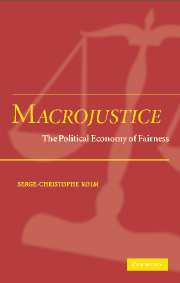Book contents
- Frontmatter
- Contents
- Presentation
- PART ONE BASES: CONSENSUS, FREEDOMS, AND CAPACITIES
- PART TWO OVERALL DISTRIBUTIVE JUSTICE: ELIE (EQUAL LABOUR INCOME EQUALIZATION)
- 7 Equal labour income equalization: General presentation
- 8 Models of labour and productivity
- 9 Equal duration income equalization
- 10 Information
- 11 Income justice
- 12 General equal labour income equalization: The model
- 13 Involuntary unemployment
- PART THREE COMPARISONS WITH POLICIES AND PHILOSOPHIES
- PART FOUR THE DEGREE OF COMMUNITY, EQUALITY, RECIPROCITY, AND SOLIDARITY
- PART FIVE COMPARISON WITH ECONOMICS' SOCIAL ETHICS
- References and bibliography
- Index
12 - General equal labour income equalization: The model
Published online by Cambridge University Press: 31 July 2009
- Frontmatter
- Contents
- Presentation
- PART ONE BASES: CONSENSUS, FREEDOMS, AND CAPACITIES
- PART TWO OVERALL DISTRIBUTIVE JUSTICE: ELIE (EQUAL LABOUR INCOME EQUALIZATION)
- 7 Equal labour income equalization: General presentation
- 8 Models of labour and productivity
- 9 Equal duration income equalization
- 10 Information
- 11 Income justice
- 12 General equal labour income equalization: The model
- 13 Involuntary unemployment
- PART THREE COMPARISONS WITH POLICIES AND PHILOSOPHIES
- PART FOUR THE DEGREE OF COMMUNITY, EQUALITY, RECIPROCITY, AND SOLIDARITY
- PART FIVE COMPARISON WITH ECONOMICS' SOCIAL ETHICS
- References and bibliography
- Index
Summary
THE GENERAL CASE
The formalization of labour and productivity set up in Chapter 8 permits the precise presentation of the logic of the properties discussed in Chapter 7, in cases more general than those where labour is representable by a quantity or duration (possibly adjusted for differences in other characteristics) and output is proportional to it, which were the focus of Chapter 9. This is the topic of the present section, whereas Section 2 comes back to the case of unidimensional labour, but with a general production function, a case which will find an application in the treatment of involuntary unemployment in the next chapter.
The solution
Individuals in number n indexed by i each have a labour denoted as a set ℓi of chosen characteristics. Individual i working ℓi earns pi(ℓi, where pi is her production function. We have pi(0) = 0 (ℓi = 0 means that there is no labour: its duration is zero and the other characteristics are undetermined).
The obtained distributive justice consists of the equal sharing of the rent-rights in given productive capacities, that is, of the value of the production functions pi(). The value of these functions consists of the fact that they yield both income for labour and leisure for the labour necessary for obtaining a given output or income. This distributive allocation can only be in terms of the goods considered in the problem: income (or consumption goods) and leisure.
- Type
- Chapter
- Information
- MacrojusticeThe Political Economy of Fairness, pp. 207 - 211Publisher: Cambridge University PressPrint publication year: 2004



